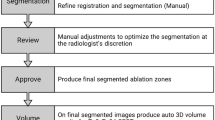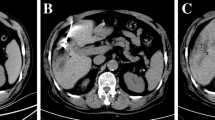Abstract
Purpose
To assess the feasibility and outcome of microwave ablation (MWA) of hepatic tumors in anatomically challenging locations.
Materials and Methods
A total of 94 patients with 174 hepatic tumors referred for CT-guided MWA were included in this retrospective institutional review board-approved study. One hundred and twenty-five tumors (median size 17 mm, range 12–24 mm) with subcapsular location (n = 91) and/or in which a transpleural approach was applied (n = 53) were identified (group 1) and compared to tumors with a central intrahepatic location (group 2; n = 49, median size 19 mm, range 12–23 mm). Technical success, complications and local tumor progression (LTP) were evaluated. Risk factors were analyzed using univariate analysis, logistic regression and Kaplan–Meier curves (p < 0.05 deemed significant).
Results
Technical success was 100% in both groups. In group 1, complications occurred in n = 31 tumors (24.8%; pneumothorax n = 20; hematoma n = 11). Complications occurred significantly less often in group 2 (8.2%; n = 4 (hematoma); p = 0.011). There were no major complications. Transpleural approach and number of capsule punctures were identified as risk factors for complications (all p < 0.05). Median follow-up was 265 days. LTP was comparable between both groups (13.6 vs. 10.2%; p = 0.41). Use of hydrodissection was the only independent factor associated with LTP (p = 0.03, HR 3.29).
Conclusion
CT-guided hepatic MWA of subcapsular tumors and subdiaphragmatic tumors requiring a direct or transpleural approach is feasible with increased minor but not major complications. LTP did not differ significantly between both groups.




Similar content being viewed by others
References
Jones C, Badger SA, Ellis G. The role of microwave ablation in the management of hepatic colorectal metastases. Surgeon. 2011;9(1):33–7.
European Association For The Study Of The Liver, European Organisation For Research And Tratment Of Cancer. EASL-EORTC clinical practice guidelines: management of hepatocellular carcinoma. J Hepatol. 2012;56(4):908–43.
Ahmed M, Solbiati L, Brace CL, et al. Image-guided tumor ablation: standardization of terminology and reporting criteria—a 10-year update. Radiology. 2014;273(1):241–60.
Liang P, Wang Y. Microwave ablation of hepatocellular carcinoma. Oncology. 2007;72(Suppl 1):124–31.
Meloni MF, Chiang J, Laeseke PF, et al. Microwave ablation in primary and secondary liver tumours: technical and clinical approaches. Int J Hyperth. 2017;33(1):15–24.
Kim YJ, Raman SS, Yu NC, Busuttil RW, Tong M, Lu DS. Radiofrequency ablation of hepatocellular carcinoma: Can subcapsular tumors be safely ablated? AJR Am J Roentgenol. 2008;190(4):1029–34.
Teratani T, Yoshida H, Shiina S, et al. Radiofrequency ablation for hepatocellular carcinoma in so-called high-risk locations. Hepatology. 2006;43(5):1101–8.
Shirai K, Tamai H, Shingaki N, et al. Clinical features and risk factors of extrahepatic seeding after percutaneous radiofrequency ablation for hepatocellular carcinoma. Hepatol Res. 2011;41(8):738–45.
Head HW, Dodd GD, Dalrymple NC, et al. Percutaneous radiofrequency ablation of hepatic tumors against the diaphragm: frequency of diaphragmatic injury. Radiology. 2007;243(3):877–84.
Kim YK, Kim CS, Lee JM, Chung GH, Chon SB. Efficacy and safety of radiofrequency ablation of hepatocellular carcinoma in the hepatic dome with the CT-guided extrathoracic transhepatic approach. Eur J Radiol. 2006;60(1):100–7.
Smolock AR, Lubner MG, Ziemlewicz TJ, et al. Microwave ablation of hepatic tumors abutting the diaphragm is safe and effective. AJR Am J Roentgenol. 2015;204(1):197–203.
Shibata T, Shibata T, Maetani Y. Transthoracic percutaneous radiofrequency ablation for liver tumors in the hepatic dome. J Vasc Interv Radiol. 2004;15(11):1323–7.
Park BJ, Byun JH, Jin YH, et al. CT-guided radiofrequency ablation for hepatocellular carcinomas that were undetectable at US: therapeutic effectiveness and safety. J Vasc Interv Radiol. 2009;20(4):490–9.
Toyoda M, Kakizaki S, Horiuchi K, et al. Computed tomography-guided transpulmonary radiofrequency ablation for hepatocellular carcinoma located in hepatic dome. World J Gastroenterol. 2006;12(4):608–11.
Koda M, Ueki M, Maeda Y, et al. Percutaneous sonographically guided radiofrequency ablation with artificial pleural effusion for hepatocellular carcinoma located under the diaphragm. AJR Am J Roentgenol. 2004;183(3):583–8.
de Baère T, Dromain C, Lapeyre M, et al. Artificially induced pneumothorax for percutaneous transthoracic radiofrequency ablation of tumors in the hepatic dome: initial experience. Radiology. 2005;236(2):666–70.
Kang TW, Lim HK, Lee MW, et al. Long-term therapeutic outcomes of radiofrequency ablation for subcapsular versus nonsubcapsular hepatocellular carcinoma: a propensity score matched study. Radiology. 2016;280(1):300–12.
Filippiadis DK, Binkert C, Pellerin O, Hoffmann RT, Krajina A, Pereira PL. Cirse quality assurance document and standards for classification of complications: the cirse classification system. Cardiovasc Intervent Radiol. 2017;40(8):1141–6.
Iguchi T, Inoue D, Yabushita K, et al. Effect of CT fluoroscopy-guided transpulmonary radiofrequency ablation of liver tumours on the lung. Br J Radiol. 1016;2012(85):e373–7.
Miura H, Yamagami T, Terayama K, Yoshimatsu R, Matsumoto T, Nishimura T. Pneumothorax induced by radiofrequency ablation for hepatocellular carcinoma beneath the diaphragm under real-time computed tomography-fluoroscopic guidance. Acta Radiol. 2010;51(6):613–8.
Patel PA, Ingram L, Wilson ID, Breen DJ. No-touch wedge ablation technique of microwave ablation for the treatment of subcapsular tumors in the liver. J Vasc Interv Radiol. 2013;24(8):1257–62.
Francica G, Meloni MF, de Sio I, et al. Radiofrequency and microwave ablation of subcapsular hepatocellular carcinoma accessed by direct puncture: safety and efficacy. Eur J Radiol. 2016;85(4):739–43.
Sartori S, Tombesi P, Macario F, et al. Subcapsular liver tumors treated with percutaneous radiofrequency ablation: a prospective comparison with nonsubcapsular liver tumors for safety and effectiveness. Radiology. 2008;248(2):670–9.
Kim YS, Rhim H, Cho OK, Koh BH, Kim Y. Intrahepatic recurrence after percutaneous radiofrequency ablation of hepatocellular carcinoma: analysis of the pattern and risk factors. Eur J Radiol. 2006;59(3):432–41.
Kitchin D, Lubner M, Ziemlewicz T, et al. Microwave ablation of malignant hepatic tumours: intraperitoneal fluid instillation prevents collateral damage and allows more aggressive case selection. Int J Hyperth. 2014;30(5):299–305.
Acknowledgement
This work was supported by a grant from the Deutsche Forschungsgemeinschaft (Grant Number RI2592/1-1).
Author information
Authors and Affiliations
Corresponding author
Ethics declarations
Conflict of interest
The authors declare that they have no conflict of interest in relation to this work.
Ethical Approval
All procedures performed in studies involving human participants were in accordance with the ethical standards of the institutional and/or national research committee and with the 1964 Helsinki Declaration and its later amendments or comparable ethical standards. For this retrospective study, informed patient consent was waived by the local institutional review board.
Rights and permissions
About this article
Cite this article
Vo Chieu, V.D., Werncke, T., Hensen, B. et al. CT-Guided Microwave Ablation of Liver Tumors in Anatomically Challenging Locations. Cardiovasc Intervent Radiol 41, 1520–1529 (2018). https://doi.org/10.1007/s00270-018-2007-z
Received:
Accepted:
Published:
Issue Date:
DOI: https://doi.org/10.1007/s00270-018-2007-z




